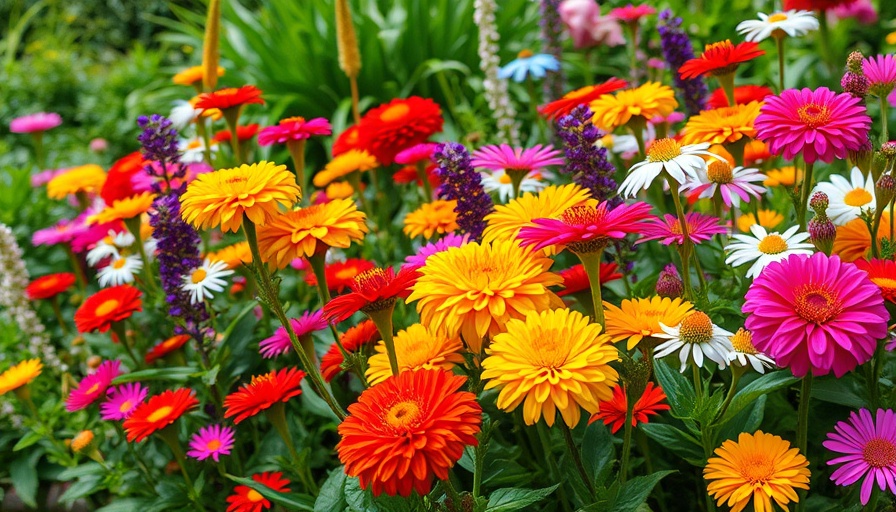
Embrace the Beauty of Imperfection with Chaos Gardening
In a world where precision and perfection often dominate, chaos gardening offers a refreshing alternative that embraces spontaneity and natural beauty. This low-maintenance gardening approach has taken social media by storm, particularly on TikTok, where influencers showcase lush gardens formed by allowing plants to grow freely. With over 8,000 videos dedicated to chaos gardening, it’s clear that this organic method resonates with both seasoned and novice gardeners alike.
What Is Chaos Gardening?
Chaos gardening is a technique that encourages a more natural, unstructured form of gardening. Rather than planting seeds in perfect rows or organized patterns, chaos gardening involves scattering a variety of seeds across the garden bed. This method fosters a mix of flowers, herbs, and vegetables, allowing them to find their own space and thrive with minimal human intervention.
Linda Vater, a garden designer from Oklahoma, emphasizes the effortless nature of chaos gardening, explaining that it requires very little maintenance throughout the growing season. The result is a vibrant and diverse garden that mirrors the unrefined beauty of nature itself. Interestingly, the philosophy behind chaos gardening isn’t entirely modern; it draws on gardening practices from centuries past when cottage and wildflower gardens thrived without the constraints of strict aesthetics.
Why Is Chaos Gardening Trending?
The popularity of chaos gardening has surged recently, fueled largely by social media platforms. Garden influencers on TikTok have turned this carefree approach into a celebrated style, highlighting its accessibility to anyone looking to cultivate a garden. Gardening has a long history of surprising moments; whether it’s a rogue zucchini sprouting alongside compost or flowers appearing where they weren’t intentionally planted, the essence of spontaneity is beautifully captured in chaos gardening.
By intentionally promoting a more laid-back approach to gardening, enthusiasts are rediscovering the joy of unexpected blooms. This trend clothes itself in the nostalgic feel of traditional gardening practices while also aligning with contemporary desires for minimal maintenance and maximum reward.
Creating Your Own Chaos Garden
Starting your own chaos garden can be an enjoyable and liberating experience. Here are some simple steps to guide you:
- Choose Your Location: Look for a sunny or partially sunny spot with good drainage. Ideally, your spot doesn’t require perfect aesthetic standards; the goal is a viable space for plants to thrive.
- Prepare the Soil: While spontaneity defines chaos gardening, a bit of initial groundwork can be beneficial. Lightly loosen the topsoil to help your seeds settle in while removing any heavy weeds.
- Pick Your Plants: Opt for a mix of regional plants—approximately 75% native and 25% non-native—to ensure a balanced ecosystem in your garden. However, a common misconception exists that all native plants are inherently beneficial; certain varieties can grow aggressively, so choose wisely.
The Advantages and Challenges of Chaos Gardening
Every gardening method has its pros and cons. Chaos gardening offers several unique benefits. Primarily, it requires much less involvement than traditional gardening, making it ideal for busy individuals or those new to gardening. Moreover, by allowing plants to grow as they please, you cultivate a garden that highlights biodiversity.
On the flip side, the unpredictability of chaos gardening can also pose challenges. Weeds can thrive alongside your plants, and without a regular maintenance schedule, certain species may dominate, reducing biodiversity. However, many gardeners find the beauty of surprise blooms worth the occasional weed pull.
Relevance in Today’s Fast-Paced World
In our busy lives, the allure of chaos gardening lies in its simplicity and emphasis on nature over meticulous control. As more people yearn for a connection to the natural world, this approach reflects a growing desire to lessen the burdens of modern life. Rather than the anxiety associated with perfection, chaos gardening invites a release into the organic flow of growth and change, reminding us of the joy found in nature.
If you’re feeling drawn to this trend or simply wish to garden in a more stress-free manner, now's the time to embrace chaos gardening. Let your plants take the lead, and enjoy the surprises that will flourish in your garden space.
 Add Row
Add Row  Add
Add 




Write A Comment